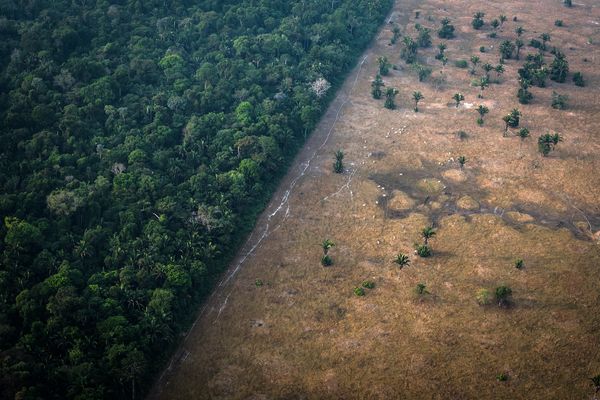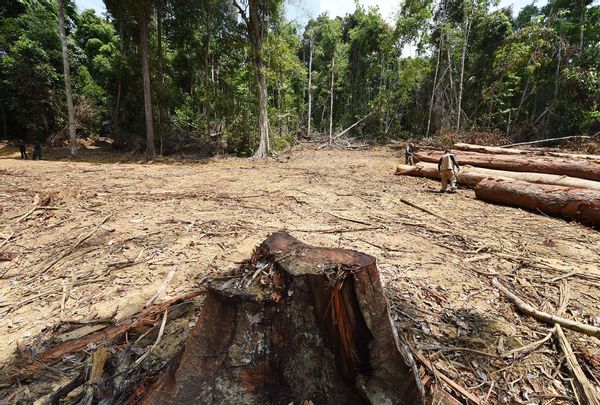
The world has watched, gripped by climate anxiety, the growing frequency and intensity of natural disasters as some of the effects of global warming. The planet's biological clock seems to be ticking faster as years go by. Back in 2015, when the Paris Agreement recommended that countries strive to limit global average temperature to 1.5ºC above pre-industrial levels by 2100, the challenge looked achievable for the international community. Now, the global rush for climate action grows in urgency as recent projections show that, even in optimistic scenarios, we may reach the 2ºC mark by the end of the century — unless immediate measures are taken.
Amid collective efforts to preserve natural resources, some places have stayed in the spotlight as symbols of Earth's biological treasures. The Amazon is one of these places: an enormous carbon sink with a global climate regulation power, sprawling across more than 6.7 million square kilometers. It is the largest and most biodiverse tropical rainforest in the world and is also home to millions of species — most yet to be discovered and cataloged.
Implementing effective policies to protect the Amazon, however, might be impacted by the fact that much of its areas are still understudied, which means biodiversity in such regions remains understudied and unknown. In its Brazilian territory, which comprises 60% of the forest's total area, more than half of the uplands (non-flooded locations) haven't been assessed.
Implementing effective policies to protect the Amazon might be impacted by the fact that much of its areas are still understudied.
That's one of the key findings of a cross-national study recently published in Current Biology, part of an extensive data-collection process that involved about 500 researchers from Brazil and other countries. The research highlights that about 54% of upland, 17% of wetland and 27% of aquatic habitats in the Brazilian Amazon have less than 0.1% of research probability (that is, extremely low chances of ecological research being conducted in these areas). This has led to knowledge gaps that, as the study points out, are intensified by the inherent risk of species becoming extinct in these understudied areas, even before they're researched.
All data collected is part of a collaborative research initiative called Synergize, and according to lead researcher Raquel de Carvalho, a postdoctoral fellow at the Institute of Advanced Studies of the University of São Paulo (USP), the compiled information "largely meets the criteria of other global databases, proving to be valuable in improving the Amazon region's representation in future investigations about anthropogenic changes at a worldwide level."
"We find similar data deficiency in other regions where few people live, like the Congo Basin in Africa, and the island of New Guinea, as well as in the deep seas."
"The paper is right to shine a spotlight on knowledge gaps regarding Amazon biodiversity," said Thomas Brooks, chief scientist at the International Union for Conservation of Nature (IUCN). He mentioned that out of the 34,869 terrestrial vertebrate species that are assessed globally against the IUCN Red List Categories and Criteria to date, 3,517 (14%) are categorized as "Data Deficient" — which means insufficient data are available to assess the species extinction risk. It's difficult to conserve a species if you know nothing about it. "The prevalence of Data Deficiency is very similar for Brazil, which holds 398 Data Deficient terrestrial vertebrate species out of 4,229 assessed in total (9%)," Brooks added.

Adopting a machine-learning model framework based on metadata of over 7,600 sampling sites from multiple ecological community groups, the study mapped research probability across the Brazilian Amazon using key criteria such as the sites' accessibility and distance to research facilities. The authors found that logistics are a major driver of research activity in the Amazon, since areas with the highest research probabilities are located near facilities such as universities and institutes.
"We have to build communities of specialists for most taxonomic groups of the organisms we're going to collect."
"Better-studied places tend to be those close to cities and roads, while extensive regions of low human population density like the Amazon tend to be well less studied," Brooks observed. "We find similar data deficiency in other regions where few people live, like the Congo Basin in Africa, and the island of New Guinea, as well as in the deep seas," he said.
Aside from logistical obstacles, Unicamp emeritus professor Carlos Joly, a member of the Brazilian Academy of Sciences and coordinator of the Brazilian Platform on Biodiversity and Ecosystem Services (BPBES), highlighted the lack of local experts for all animal and plant groups as another gap that affects biodiversity research in the region.
"This gap is much more difficult to fill short-term, as we're not able to train taxonomists with the speed we need, for groups in which we don't have specialists in Brazil," he explained. Joly believes that establishing partnerships with foreign institutions is an essential strategy for reducing the expertise gap. "We have to build communities of specialists for most taxonomic groups of the organisms we're going to collect. I think it's the way we can solve this in a short period of time," he said.
"When we don't know what species comprise a forest, we can't understand its functioning, nor can we predict the impact of climate change on that place's biodiversity."
Thinking about less-researched sites through a non-expert lens might lead us to the impression that, since many species have been assessed in similar regions of the forest, we can then predict their occurrence in understudied areas. But this assumption does not suffice in such a large and biodiverse place like the Amazon, where "we do not have similar areas among great distances since each combination of biotic and abiotic factors produces different environments," explained the study researcher Angelica Resende, a current postdoctoral fellow at the University of Stirling. "We can try to predict that some areas are 'similar' in some aspects by combining environmental variables such as climate and soils, but always with degrees of uncertainty, since we do not know all the factors affecting each species," she added.
According to the study, 15% to 18% of the less-researched locations in the Brazilian Amazon might also be vulnerable to severe human-induced changes in climate or land use by mid-century.
"When we don't know what species comprise a forest, we can't understand its functioning, nor can we predict the impact of climate change on that place's biodiversity," Joly said. "The better the initial data, about how the forest functions nowadays, the better will be the modeling of future scenarios," he added.

Resende described that "with enough knowledge about the spatial patterns and occurrence of species, it would be possible to prioritize protecting areas with higher degrees of endangered, endemic or rare species." Regarding climate change mitigation strategies, she went on, "we could focus on the conservation or restoration of areas with great carbon uptake and storage capacity."
Traditional knowledge can help bridge research gaps
The Kunming-Montreal Global Biodiversity Framework, adopted during the 2022 UN Biodiversity Conference (COP 15) in Canada, reinforced the long-time discussed importance of integrating indigenous populations and local communities into biodiversity conservation, restoration and sustainable use. However, according to study findings, this is another challenging commitment: although indigenous lands constitute 23% of the Brazilian Amazon, these areas have lower research probability.
Considering native communities' knowledge is pivotal for improving the assessment of species and conservation strategies.
Considering native communities' knowledge, Joly said, is pivotal for improving the assessment of species and conservation strategies. "First, because we have so much to learn from them — they know the forest better than anyone else. Moreover, because we must help preserve traditional knowledge," he emphasized.
Miguel Moraes, program senior director at the Brazilian branch of Conservation International, believes that integrating traditional knowledge into research development also involves a change in cultural perspective. "We need to rethink values, how we handle the multicultural aspect of the Amazon — because indigenous population comprises many cultures, with different values, beliefs and forms of interacting with nature," he observed.
Developed countries play an important role in reducing gaps, experts say
In early August, the eight countries representing the Amazon Cooperation Treaty Organization (ACTO) attended the Amazon summit at Belém — the capital of the Amazon-based state of Pará. Although the countries, which included Peru and Colômbia, didn't formally agree on how to end deforestation in the region, they demanded more effective measures from developed countries to prevent its destruction.
For the study researcher and Lancaster University professor Jos Barlow, one of the main steps developed countries should take to help protect the Amazon is reducing their own environmental footprints. "This includes reducing emissions from [burning] fossil fuels, as these make by far the greatest contribution to global warming, and climate change is making the conservation of the Amazon more difficult," he told Salon.
"Climate change is making the conservation of the Amazon more difficult."
According to Moraes, developed countries can provide a wide range of resources — not only financial but also technological and human (through research initiatives and partnerships with universities, for example), which he considers essential strategies for fighting Amazon's deforestation. But ensuring that resources are implemented responsibly is also crucial, he observed; otherwise, they may end up concentrated in the same groups and therefore perpetuate inequalities. "We need payment-by-result mechanisms, green bonds, carbon credits or biodiversity credits — which have been discussed as well," he explained.
Amid global demands for climate action, international NGOs also play a relevant role in policymaking. They're able to connect different actors across all levels of natural resource governance, Moraes highlighted, including in global markets with local production processes — which therefore involve several interlocutors. "This transiting ability is very important for advancing not only biodiversity studies and knowledge building, but the actual conservation and knowledge application, as well," he said.
We need your help to stay independent
Barlow ponders that, although international organizations aren't the leading sources of biodiversity research, they can also improve the work of academic and research institutions by facilitating sampling in less-covered regions. This could be implemented through longer-term partnerships with organizations based in the Amazon, he said. "International NGOs and intergovernmental organizations could also play an important role in the synthesis and dissemination of new research, making sure it contributes to debates at international fora such as the climate and biodiversity COPs."
The challenges posed by knowledge gaps "should never be used as an excuse not to act," observed Brooks. Protecting the world's most biodiverse forest is a commitment that all international actors have in common. "We must understand that this is a shared challenge. Biodiversity doesn't consider political borders," concluded Moraes. The future is, indeed, in our lands.







